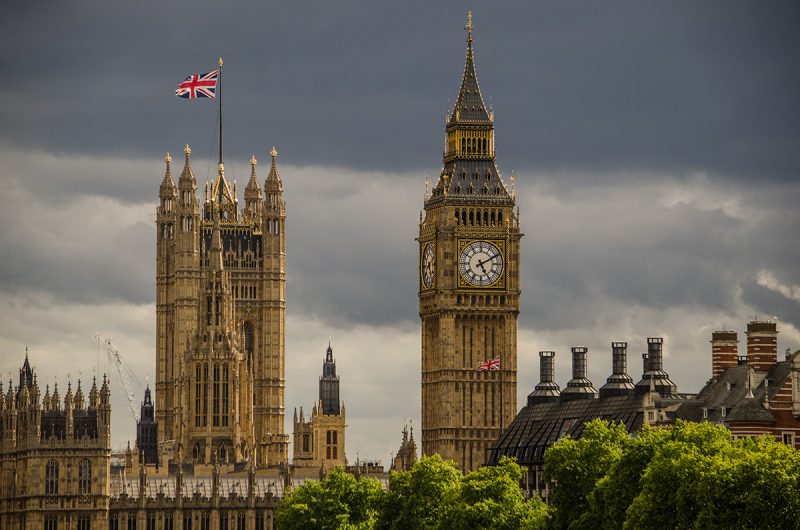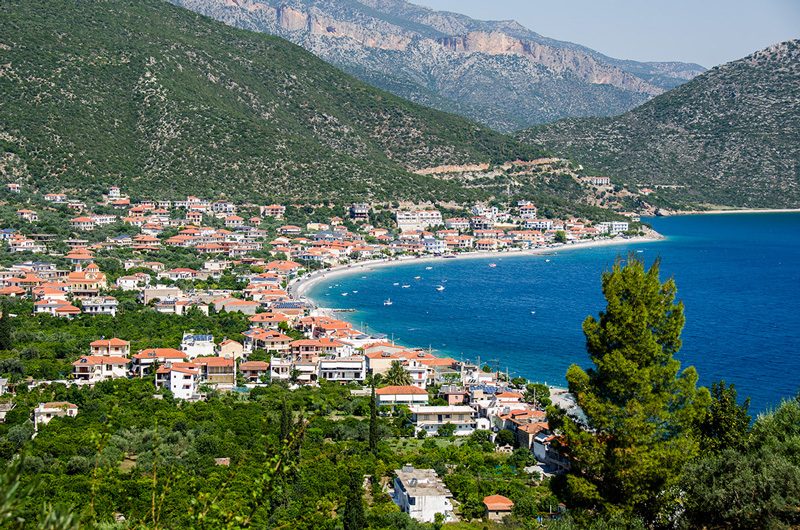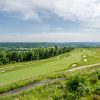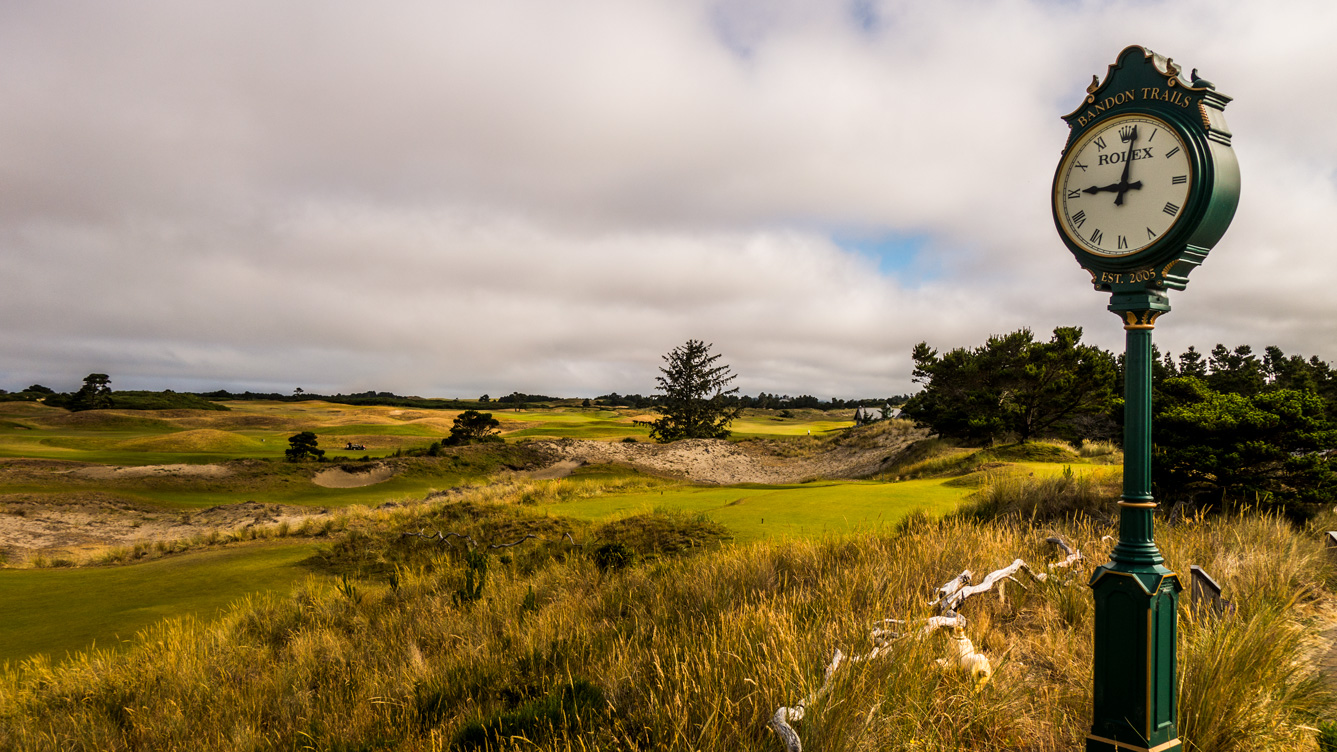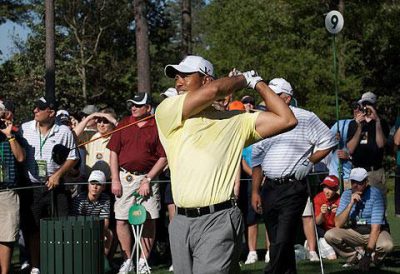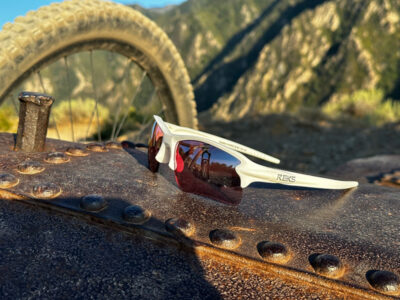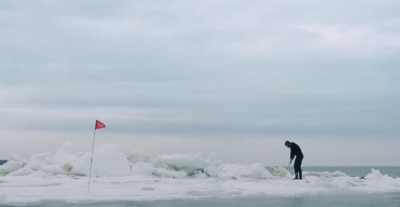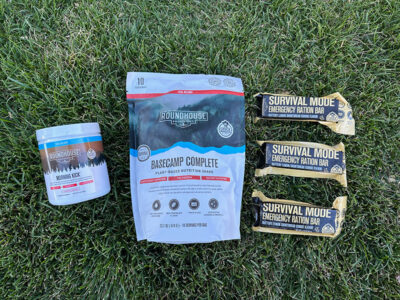Review: Pete Dye Course at French Lick Resort
Categories: Course Reviews • Golf • Golf Courses • Golf For Women • HOG World Tour • Reviews • Travel
Tags: French Lick • Golf Travel • Indiana Golf • Pete Dye • Travel
It has taken a few weeks to process my experience at French Lick Resort’s Pete Dye Course. I was also slightly sidetracked by a little trip to Scotland in that timeframe. The dust in my golf cranium has settled. I’m ready to try and tackle this big review of a big golf course.
French Lick Location
First off, let’s get the location figured out. French Lick Resort is in Larry Bird country, the towns of French Lick and West Baden Springs in southern Indiana. The closest major city and airport is Louisville, Kentucky. Next would be Cincinnati and Indianapolis. The resort sits on a large and historic estate which dates back to 1845.
The Dye Course is a 5-10 minute drive from the West Baden Springs Hotel and the French Lick Hotel and Casino. The course lies on one of the highest points of elevation in Indiana, producing a 40 mile panoramic view.
Pete Dye Course Key Facts
First off, one must know who Pete Dye is. Pete Dye is a Hall of Fame golf course architect who has built some of the most famous courses in the world. Some of Pete Dye’s most notable courses include Kiawah Island Golf Resort, Harbour Town Golf Links, TPC Sawgrass Stadium (home of THE PLAYERS), Whistling Straits, and PGA West.
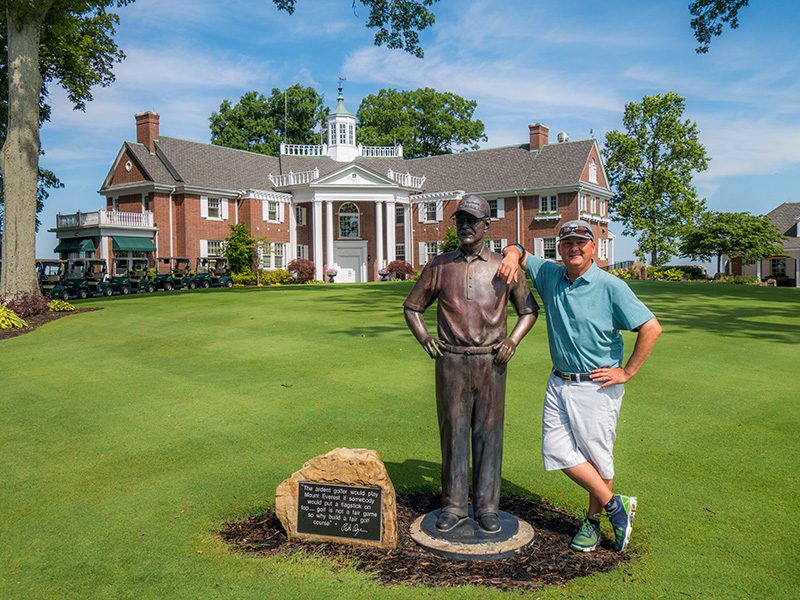
Pete Dye and me
The Pete Dye Course at French Lick is certainly one of the most difficult courses in the USA, if not the world. The course rating from the tips is an unheard of 80.0. The slope is a massive 148. It’s hard to translate those numbers for those who don’t understand rating and slope. A skilled professional on average would shoot an 80 on this course, on a good day.
The course plays to a par value of 72. The total yardage is 8,102. Amongst that hefty yardage is par-3 16th hole which measures 305 yards. If the length isn’t tough enough, there’s water down the entire right side.
Tee
The views presented to the golfer from the tees are tremendous, challenging, and worthy of not only a solid tee shot, but a solid shutter release of a nice DSLR camera.
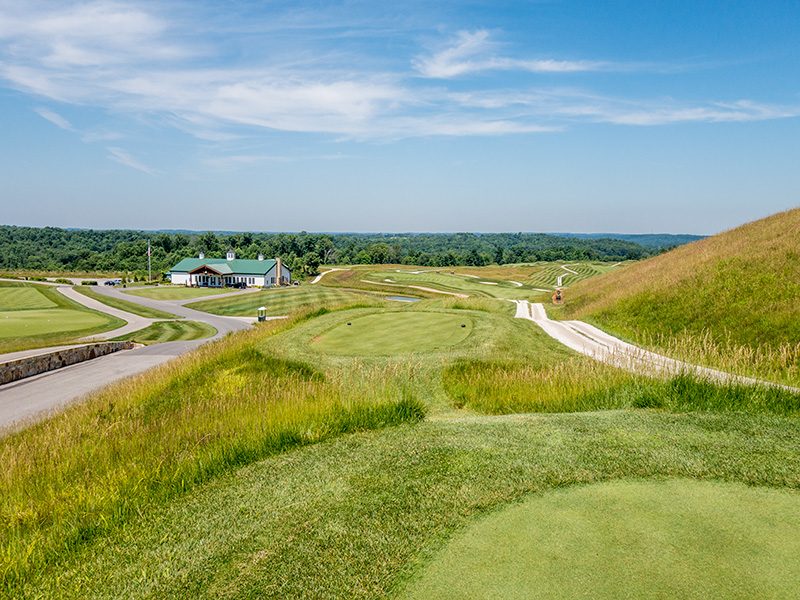
1st Tee – The sliver of fairway in line with the cart path is the target
Where to aim from the tee on the Pete Dye course is a tough call on nearly every hole. Visually the landing areas look extremely narrow and seem like they’re miles away. Wait a sec… that’s because they are extremely narrow and miles away. One must know how far they hit their drives or layup shots, exactly. Then execute a near perfect shot to hit that precise spot to keep a ball in the fairway. And I’m talking about the par-3’s! I kid. I kid. Sort of.
St Andrews New Course Review
Categories: Course Reviews • Golf • Golf Course Architecture • Golf Courses • Golf For Women • Reviews • Travel
Tags: Balcomie Links • Course • Golf Travel • Old Course • Old Tom Morris • Scotland • St. Andrews • Travel
Now that I’ve confirmed the pending third HOG World Tour trip to St Andrews, Scotland, I can’t help having Scotland on my mind. It is a magical place. Sadly 99.999% of the courses in the United States do not play like true scottish links courses. Scottish golf is a natural, hard style of golf I far prefer to the overly-soft, over-watered, too green, over-manicured courses here in the USA.
One thing most golfers who have not been to there don’t realize is that there are a ton of courses in the town of St Andrews, not just the Old Course. That’s why I’m always giving people grief when they refer to the Old Course as St Andrews. “Hey have you played St Andrews?” they ask. I say, “which course?” St Andrews is the name of the town, not the course(s). In the town itself the other courses besides the Old Course include the New Course, Jubilee Course, Eden Course, Strathtyrum Course, The Dukes, and the Balgove Course. All but the Balgove are within walking distance. In a few minutes by car one can find even more courses: Castle Course, Torrance Course, Kittocks Course, Saint Andrews Bay Course, and Kingsbarns Golf Links.
The closest course to the Old Course is the New Course. While the Old Course dates back to around 1400, the “New” Course opened in 1895. Yeah, that’s “new” alright. The New is literally next to the Old. You can miss a fairway on the Old and the ball may end up on the New, and vice versa. I don’t recommend that though, because the New is out of bounds if you are on the Old and vice versa.
New Course Overview
Old Tom Morris is the architect of the New Course. The new is a par-71 course which tips out a 6,625 yards, short by modern standards. The new has many very similar designs and feels as the Old does, but is a little more straightforward and less quirky.
The course rating is 72.8 with a slope of 127 from the tips. For those of you in the UK, the standard scratch score (SSS) is 73. The rating would make the New just a tiny bit tougher than it’s next door neighbor, the Old.
Tee
From the tee, the new presents some great challenges. The course can be a wee bit (as they say in Scotland) tight. Errant tee shots will be penalized by bunkers, deep rough and in the worst case, gorse. If you don’t know what gorse is count yourself lucky. Gorse is a very nasty dark green bush with thorns which feasts on a strict diet of golf balls and the occasional golfer. Going into the gorse after a ball is usually not a good idea, unless you like scratching the hell out of yourself and ripping your fine golf apparel to shreds.

Some tee shots can be intimidating
Given the shorter nature of this course and the typical hard ground, driver is not necessary on many of the par-4 or even par-5 holes. The longest par-5 is 518 yards. Once again, distance isn’t the most important part of the tee shot at the New. Accuracy is.
Fairway
The fairways can be tight on the New Course, but fairly flat in most places. If the golfer has managed to avoid the pitfalls mentioned in the tee description, the approach from the fairway is fairly straightforward.

Left rough approach on the 18th hole
If the golfer misses the fairway but avoids bunkers and gorse, the rough can be very thick and inconsistent. Difficult lies in the rough may be tempting for the golfer to hit the hero shot, but it is often wise to be more conservative and get the ball back into play.
Green
The greens at the New are quite different than the Old. They’re considerably smaller and less undulating but still guarded well via bunkering and adjoining gorse and rough areas.

Because of the smaller greens, the hard ground, and the ways the greens are protected by bunkering or natural obstacles, I find the greens at the New fairly hard to hit. This puts a premium on short game. A green reached in regulation is not an overly difficult two-putt proposition like the gigantic greens on the Old.
Amenities
The St Andrews Links Clubhouse is a very spacious and large facility featuring the pro shop, Swilcan Restaurant and lockers with showers. I’ve enjoyed a few meals in the Swilcan Restaurant and knocked back some refreshing beverages while overlooking the 18th green. Such a great spot.
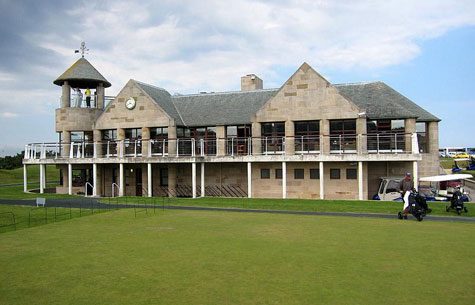
St Andrews Links Clubhouse
Next to the clubhouse is a nice practice green for getting the feel and working on short game. There is no driving range. The nearest range is a bit of a walk or very short drive to the St Andrews Links Golf Academy.
Tip
The St Andrews Links Trust sells a few different great golf packages. I highly recommend purchasing a three-day or seven-day “ticket.” These packages allow the golfer to play unlimited golf in either three days or seven days on the six Links Trust courses other than the Old. In the middle of the summer there is so much daylight that a hardcore golfer could literally play 3-4 rounds in ONE DAY. I’ve done the 3-day twice now and loved it. In one day I played 18 on the the Jubilee, 18 on the New, and a relaxing 9-holes on the Strathtyrum Course.
Final Thoughts
The New is a fantastic links style golf course. It’s a great course on its own and serves as an excellent alternative or backup for times when the golfer is not able to get a tee time on the Old Course. Plus the cost is a fraction of the Old.
I highly recommend experiencing the New Course when traveling to St Andrews to play golf. The New provides a tremendous and satisfying links experience.
Related Links
Balcomie Links Golf Course, Crail Scotland
Fairmont Hotel St Andrews Review
Ardgowan Hotel St Andrews Review
Golf Course Review – Journey at Pechanga
Categories: Course Reviews • Golf • Golf Courses • Golf For Women • Golf Life • Golf Lifestyle • HOG World Tour • Reviews • Travel
Tags: California Golf • Golf Travel • Pechanga • Southern California • Travel
I’ve heard a lot about the golf course at Pechanga and I’m glad I was finally able to make the short trip down to Temecula, California to check it out. The course is called Journey, or sometimes referred to as Journey at Pechanga.
Location Location Location
Journey at Pechanga is located on the property of the fabulous Pechanga Indian Reservation resort/casino in Temecula, California. Temecula is in a perfect location roughly midway between San Diego and Los Angeles. When booking my flights it was nice to be able to choose between the LA airports or San Diego. I ended up choosing San Diego this time around because the cost was a little lower.
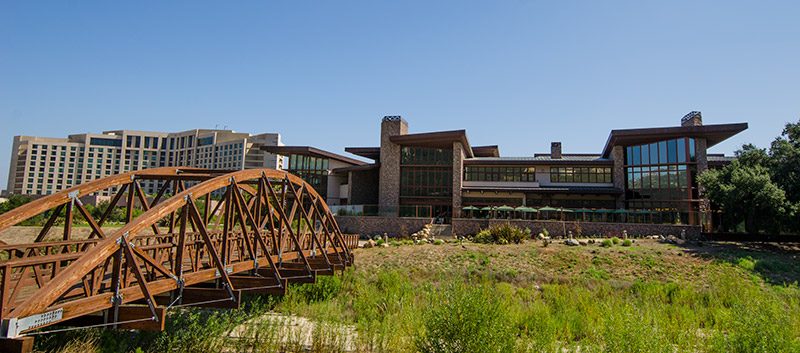
Pechanga Hotel Left – Golf Clubhouse Right
Journey’s routing brings it in the hills behind the resort, and gives the course some great elevation changes and views.
Overview
Pechanga is a very challenging golf course featuring five sets of tees. With five sets of tees players can choose how much of the challenge, or journey, they wish to bite off. From the tips, the Copper tees, the course plays to a par-72 with a course rating of 74.8 and a slope of 142. In plain English that’s one tough journey.
The course architect for Journey is Arthur Hills. I’ve played many of Mr. Hills’s courses and while he has some architectural signatures, his design at Pechanga is quite unique and original on a few levels. Part of the uniqueness of the course design is the challenges Hills had in preserving sacred areas and sacred items on the property. Players who are unaware of these sacred items might complain or wonder why there’s a large tree in the of the fairway. After solid drives I found myself directly behind a couple of those large trees with no shot at the green. I was irritated for only as long as it took me to remember these are sacred trees. Then I took my bogey and moved on.
There are several spots on the course where huts can be found, and some very old historic structures.
Modern huts, homes, are not on the course and never will be. I love courses like this which aren’t developed for the strict reason of selling lots. Major points scored on this for Pechanga.
Tee
Tee shots at Pechanga are probably the strength of the course design. Hitting the tee shot accurately is perhaps the most important shot on just about every hole. Many tee shots present forced carries and very large elevation changes, requiring precision and good math skills at figuring out the yardage to elevation change difference. Coming from a mountainous area, the elevation changes were right at home for me.
Tee shots sometimes present the player with risk/reward options, like the par-4 5th hole. At around 300 yards a bomber could play aggressive and try to drive the green. There’s not much room for error though with a stream dissecting the landing area and a lake the player must carry. On my first time around the course I chose a conservative route on that tee shot, hitting hybrid to the left fairway. From there it was a sand wedge to five feet and my first birdie of the day. The second time I played it I played more aggressive and ended up making bogey.
The next hole (#6) is a par-4 that provides the most dramatic elevation drop of about 300 feet. Drives seem to stay in the air for an hour or two from that tee box. In the photo below I’m about to launch one on #6.

Par-4 6th Hole Tee
Another great tee is on the par-3 17th (pictured below), with a large drop and a view of the resort and parts of Temecula in the background.

Pechanga Golf Course 17th Green
I almost aced 17 on my first go-round. Unfortunately my playing partners just missed out on some free beer.
Fairway
The fairways at Pechanga are generally fairly wide and not terribly difficult. If you’ve managed to find the fairway, you won’t be faced with a tricky or unfair stance, but you might have issues due to the aforementioned sacred trees. It happened to me twice, once on the first hole and once on the par-5 9th.

First fairway before the early morning marine layer has burned off. Note the trademark tree in fairway…
A few fairways are split, giving the player two routing options. One option is often for the more aggressive player and one for the conservative.
Green
During my round at Pechanga I found the greens to roll smoothly. They were receptive to good shots, even spinning a few back. Some greens like the 18th featured large undulations and tiers while others like the 2nd and 3rd were more flat and subtle.

15th Green at Pechanga
Many greens are guarded by some stern bunkering. Greens located on the hillside often had a favorable uphill side to help deflect errant shots above the green onto the green. But that same slope would severely penalize errant shots which hit the downhill side. I know this first hand.
Flow
The gap between the 5th and 6th holes is literally about a five minute drive in a golf cart, including a massive elevation change. That may be the “Journey” right there! There’s another big gap between 16 green and 17 tee. Because of some of these long gaps between holes and the steepness of the hills I really don’t see walking the course as an option. The walk from 5-6 could take a fit individual 15-20 minutes. Those gaps make some of the routing/flow a bit on the funky side.
Practice Areas
Pechanga has a great driving range with high quality range balls. There are actual greens and bunkers in the range providing players the opportunity to play real golf shots at targets with forced carries. This is a great alternative to the ranges on some courses where the target is “north.”
The short game area is perhaps the best of the practice facilities at Pechanga though. There are several short game greens with side-hills, chipping pitching slopes, and bunkers to practice from. That’s where I should have spent most of my time, and where most players would benefit as opposed to pounding drivers all day on the range.

Short game practice area
Finally the practice green (below) provides an accurate representation of the speed and feel of the greens on the course. More importantly though, there’s a bar/cafe about 20 feet away.

Pechanga Practice Green
Amenities
The clubhouse is quite an architectural piece. Inside are the pro shop, locker rooms, and a great restaurant called Journey’s End.

Journey at Pechanga Clubhouse
The pro shop is full of a massive apparel and equipment selection. If you forgot something or need some new gear, they have it.
I had breakfast at Journey’s End a couple of times and the huevos rancheros was fantastic, along with the pancakes.
Conclusion
The Journey produces some very fun resort golf between all the great amenities the hotel and clubhouse have to offer and the Arthur Hills designed golf course itself. The course can play as relaxing or as challenging as a player may want with it’s diverse set of tees. Bring some extra balls and bring a camera.
Related Links
Journey at Pechanga photo gallery.
Pechanga Resort/Casino photo gallery.
HOG World Tour in London
Categories: Golf Lifestyle • HOG World Tour • Travel
Tags: London • Travel
The big HOG World Tour vacation is currently in London. I did not bring my sticks on this trip, just my cameras. Enjoy this one…
My trip is coming to an end and I’m sad about that, but happy to be heading home in a couple of days and getting back to golf blogging!
Greetings From Southern Greece
Categories: HOG World Tour • Miscellaneous
Tags: Greece • Travel
My HOG World Tour vacation in Greece continues from the seaside village of my grandfather on the southeastern coast of Greece.
As you can see, the place is beautiful. I have a few more days here in Greece, then off to London to cap off the trip. Then back to the regularly scheduled blogram here.
A few have expressed concern for me while here in Greece during their financial crisis. Tourists for the most part are fine here and able to access money from ATM machines with no limit. No worries.
« Previous 1 2 3 4 5 … 7 Next »

